Porcelain Insulator News
by Jack H. Tod
Reprinted from "INSULATORS - Crown Jewels of the Wire", January 1975, page 13
Preferably direct porcelain news items and questions directly to Jack H. Tod,
3427 N. 47th Place, Phoenix Ariz. 85018. All mail will be answered if reply
stamp is enclosed, and the most newsworthy items and questions of general
interest will be answered as space permits.
NOTICE
Supplement C (January 1975) to "Porcelain Insulators Guide Book for
Collectors" in now available. Contains new markings, 20 new U- number
shapes, pricing info etc. This makes a total of 931 U- numbers for different
porcelain unipart pin type shapes, but new ones that are really different enough
for drawings have now slowed to a trickle.
Order from dealers or from Jack H. Tod, 3427 N. 47th Place, Phoenix, AZ
85018. Price is $1.00 which includes first class postage. Included free with all
orders for the book plus both Supplements A and B.
Some collectors do not yet have Supplements A and B. Supplement C sent free
with orders for both supplements, and $.50 with orders for Supplement B only.
Reference the "VARLEY'S PATENT" insulator on page 17, Nov 1974
Crown Jewels. Gerald Brown (Two Buttes, Colo.) advises that this is one of C. F.
Varley's 1868 patents.
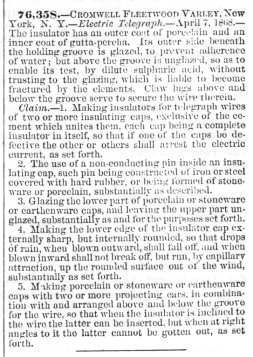 |
Image text:
76,35S-CROMWELL FLEETWOOD VARLEY, NEW York, N. Y.-Electric Telegraph.--April
7, 1868.-- insulator has an outer coat of porcelain and an inner coat of
gutta-percha. Its outer side beneath the holding groove is glazed, to prevent
adherence of water; but above the groove is unglazed so as to enable its test,
by dilute sulphuric acid, Without trusting to the glazing, which is liable to
become fractured by the elements. Claw lugs above and below the groove serve to
secure the wire therein.
Claim.--1. Making Insulators for telegraph wires of two or more insulating
caps, exclusive of the cement which unites them, each cap being a complete
insulator in itself, so that if one of the caps be defective the other or others
shall arrest the electric current, as set forth.
2. The use of a non-conducting pin inside an insulating cap, such pin being
constructed of iron or steel covered with hard rubber, or being formed of
stoneware or porcelain, substantially as described.
3. Glazing the lower part of porcelain or stoneware or earthenware caps, and
leaving, the upper part unglazed, substantially as and for the purposes set
forth.
4. Making the lower edge of the insulator cap externally sharp, but
internally rounded, so that drops of rain, when blown outward, shall fall off,
and when blown inward shall not break off, but run, by capillary attraction, up
the rounded surface out of the wind, substantially as set forth.
5. Making porcelain or stoneware or earthenware caps with two or more
projecting ears, in combination with and arranged above and below the groove for
the wire, so that when the insulator is inclined to the wire the latter can be
inserted, but when at right angles to it the latter cannot be gotten out, as set
forth.
|
He had six patents during that period, and the most likely one covering this
insulator in #76,358 of 4-7-68.
Unfortunately, our library is missing the 1868 Vol. III which has the
drawings for 1868 1st half, but the patent text indicates insulator made in
"two caps", the outer one of porcelain just as Banfill's specimen. At
least we know more now than we previously did.

The unusual N.E.G.M. glass cable insulator reported by Leslie Lidtke on page
99 of the Nov 1974 Crown Jewels is a tremendous glass insulator find, but it
should also be news to porcelain fans.
Note the U-406 in our porcelain Universal Style Chart (shown at right). This
item was cataloged as a No. 7 Cable on page 34 of the 1908 catalog of The New
Lexington High Voltage Porcelain Co.
N. R. Woodward's history relates that N.E.G.M. Co. was in business for a
brief period commencing in 1899. Now Lexington HV was founded in 1903 and made
porcelains for an estimated 10 years thereafter. It is therefore difficult to
tell who copied whom or if the two items were made concurrently.
This glass specimen is of great interest to us because a porcelain specimen
hasn't been located yet, and it tends to raise our hopes that someone will
eventually find one. New Lexington also cataloged the U-405 and U-408.
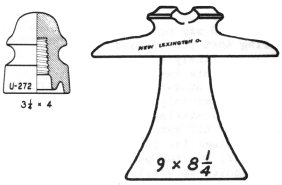
Dear Jack:
I dropped in on the Keene Bottle Show and was fortunate to get a
U-272 with "G" marking, and this Is a new one for "G"
marking.
Also added recently a very pretty NEW LEXINGTON, 0. This was standing upside
down in an antique shop of fellow who looks for insulators for me. It looked
like a Fred Locke glaze, and I sure was surprised when I turned it over and saw
the marking. It has nice graceful lines (sketched above).
Lew Hohn,
Rochester, N.Y.

Dear Jack:
I'm enclosing a photo (above left) of some porcelain bushings made by General
Porcelain Co. and which were drilled through at the factory to use as lamps. The
one on the left is cobalt blue, and the other is a spongeware type of glaze. The
pretty vase in the note was made by Thomas and has the marking I've sketched
(above right).
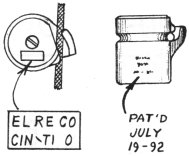
Also enclosed is a photo and sketch of an unusual self-tying knob and the
markings on it. I would appreciate any information you might have on this patent
& marking.
Jerry Turner
Goshen, Ohio
- - - - - - - - -
Dear Jerry:
This knob is patent #479,134 of July 19, 1892, Chauncey E. Conover,
Cincinnati, Ohio. C. E. Conover also had other patents on special knobs.
The knob has a normal tie-wire groove but also a slot as shown with ears that
held the wire down when the knob was rotated counterclockwise and then screwed
down.
The marking is undoubtedly for Electric Railway Equipment Co., 2900 Cormany
Ave., Cincinnati, Ohio, manufacturer of overhead line material for electric
railways and mines, ornamental street lamps, etc. No telling which porcelain
company made these for that company.
Jack


Dee Willett (Bakersfield, Cal.) recently found the above insulator and which
is an addition to the Universal style chart as U-923D. This specimen is an
off-white color as seen on other styles made by Fred Locke in the 1901-1902
period, and it has a 4-line/6-date stamp
different from the one previously recorded.

Note lower case letters in the months and also the 4-digit years instead of abbreviated years. This is
undoubtedly the first style of non-eared crosstop made by Fred Locke and in
comparable style to those made for him by Imperial and other companies in the
1895-1899 period. I estimate this specimen was made in early 1902. It is one
piece (not a glazeweld) and is Top Rest.
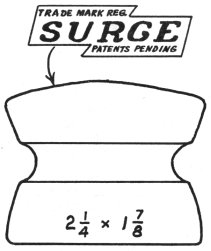
Dear Jack:
When at Washington Court House "flea market", the boys garnered
this porcelain SURGE (sketch at right), and it has the recess-embossed marking
shown by the enclosed foil impression. I looked at the other porcelain SURGE shown
on page 12 of the Nov. 1971 Crown Jewels. and this in a completely different
animal. It also has a bottom mounting slot (3/16" x 7/8").
Incidentally, I am still looking for a white U-223 two-piece tramp and a
U-197 Macomb tramp, and let me know if you hear of anyone with either of these
for swap or sale.
Jerry Turner,
Goshen, Ohio
- - - - - - - - -
Dear Jerry:
That porcelain SURGE is a good find, and these two solitary specimens sure
pose a question of just what was made for Babson's "Surge" line in
porcelain. I haven't seen others in collections, and no one has ever reported
these in use or as found in any quantity.
I have seen a U-223 tramp and several U-197 Macomb for sale in ads recently,
and I'm sure you'll get them if you persist. They're both TUF but not
unobtainable.
Jack
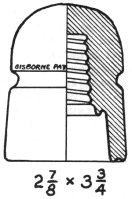
Dear Jack:
Enclosed is a photo and sketch of a white porcelain beehive and which has an
incuse "GISBORNE PATTERN" marking just above the wire groove.
Could you please send me information on this one? Who made it, what the
marking stands for, its value? Also, what in its U- number?
David Harting
N.
Canton, Ohio
- - - - - - - - -
Dear David:
This in a foreign style, and thus it isn't in the U- chart. Others have
previously asked about the Gisborne Pattern marking, but I know nothing of its
meaning. Hopefully some reader can tell us about it, and we'll print the answer.
As I understand it, these are found in Canada, and I've seen then on show tables
in the $5 to $10 price range.
Jack
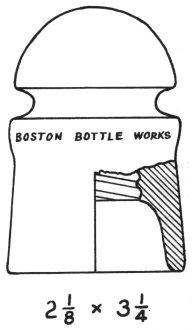
Dear Jack:
I am sending to you a cobalt blue Boston Bottle Works porcelain insulator
and would like your personal opinion on this insulator & what the value may
be. I talked to Brad Cook about it, and he recommended I contact you and that
you could tell me more about it than they could, seeing that it's porcelain
A.
J. Valek
5140 W. 7th St.
Brooklyn Hts, OH 44131
- - - - - - - - -
Dear A. J.:
Everything about this specimen leads me to believe that it is not a
legitimate insulator. My personal opinion is that this is a modern creation of
some individual. But, of course, I have no way of being 100% positive of this -
just 95%.
First, Boston Bottle Works became defunct by 1877. They made glass products,
including some insulators, and there would have been no incentive for them to
contract a ceramics company to make insulators for them.
Secondly, the insulator style is comparable to styles developed well after
1900, and the cobalt blue glazes on porcelain insulators wasn't used until
approximately 1920.
Thirdly, whereas commercial porcelain insulators are fired on prepared
unglazed firing surfaces, this item was fired on a tripod stilt such as used by
art ceramicists (and hobbiests). The very crude pin hole is undersize and is
exactly as if a threaded pin were used to make the threads in the damp clay -
and thus, not allowing for the 12% firing shrinkage,
I repeat, I could be wrong about this item being spurious, but if I were
called upon by the National Insulator Association to authenticate this specimen
for its admissibility on the premises of any NIA-sanctioned show, I would have
to rule it as a probable fake.
Needless to say, I would appreciate learning the origin of this thing or
where you happened to get it.
Jack
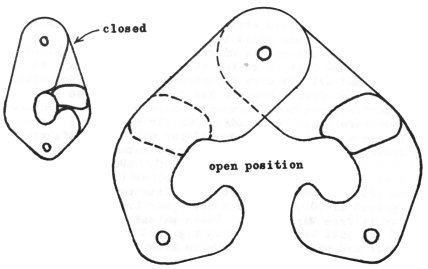
Frank Anderson (Charlotte, Vt.) has the hanger insulator sketched above. It
hangs from a cast iron bracket, opens up to accept the cable, and a wire through
the bottom hole secures it closed around the cable. It is brown, unmarked, about
7" long by 2" overall thickness.
We would like to hear from anyone who has information on these --
manufacturer, vintage, etc.
Dear Jack:
Porcelain Insulators have been "accumulating" in my basement more
or less as a sidelight to my glass insulator collection. Recently, I set about
to put these in a displayable order. The task soon became impossible because of
the variety of shapes, and no convenient numbering system like the CD numbering
system for glass.
I note in Crown Jewels and Cross Arms reference to your books for pin type
porcelain which include a style chart. In order to make some sense out of the
chaos in my basement I'm enclosing an order for your books.
... and I have an insulator with a BOCH PATENT marking and like I've sketched
(a U-928A). To what does the patent relate? If you've a copy of the patent,
please advise how I might obtain a copy....
Chuck Dittmar
825 Brookfield Ave.
Youngstown, Ohio 44512
- - - - - - - - -
Dear Chuck:
Yes, the Universal Style Chart (U- numbers) in my book is identical to
Woodward's Consolidated Design chart (CD- numbers) except that it has all the
porcelain shapes. Both charts use 1/4-size machine drawings. Part of your chaos
comes from the fact that the CD- chart has only 261 drawings for all the glass
styles including the multipart pin types (but excluding threadless), but the U-
chart has 931 different porcelain styles (no multiparts) published to date, and
new ones still keep cropping up.
You'll find a complete discussion of the Boch Patent in my book and the
history behind it. If you just want to see what this and all the more important
patents for porcelains look like, get Gerald Brown's 2nd Edition and also his
supplement. These books have all these patents reproduced for your reference.
(See ads in CJ for ordering.)
If you want an actual copy of any patent itself, you can order it from:
Commissioner of Patents
Washington, D.C. 20231
Send either (1) the patent number, or (2) the full name of the inventor and
the approximate date patent was issued. Each patent is 50 cents, and don't hold
your breath until you receive it from Washington. (Boch patent is #600,475.)
If you just want to look up a patent indicated on any insulator and which
isn't shown in Brown's books, you can do this by consulting the U.S. Patent
Gazette and the Patent Office Annual Reports (Indexes). Hundreds of libraries
are official depositories and have the complete sets of these - state
universities, state archives, many large public libraries, etc.
If the specimen has either the patent number or the patent date, or a
combination of the inventor's name and the patent date, you can usually find the
patent in the Index and then look it up in the Gazettes.
As an alternative to trying to find it yourself, send the marking data and a
sketch of the item to me, and I'll more than likely have it in my own card file
of patents if it was between 1890 & 1919 inclusive. I have nearly 1,000 of
these recorded, and the file cards have identifying information as shown below.
Jack

| 